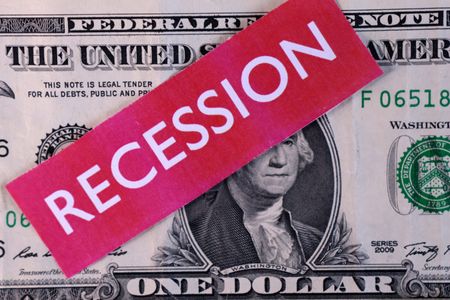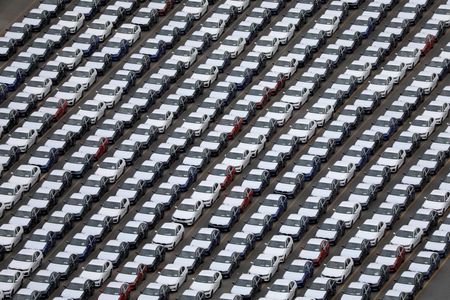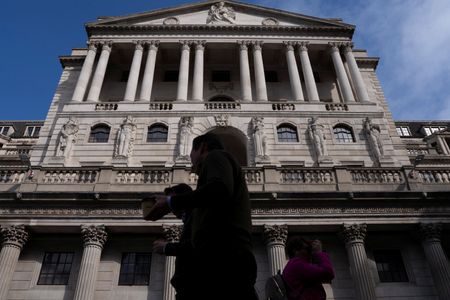By Dhara Ranasinghe and Stefano Rebaudo
LONDON (Reuters) – Global recession risks have shot back up markets’ worry list, but the readout from economic data and key financial indicators is not as clear cut as it first appears.
A 90-day pause on most reciprocal tariffs unveiled by U.S. President Donald Trump in April has eased investors’ worst fears, but the damage to business and consumer confidence is expected to hurt.
“Recession risks have risen markedly even if there are some deals struck on tariffs,” said Guy Miller, chief markets strategist at Zurich Insurance Group. “The risk of a U.S. recession is 50-50, it’s that close.”
Here’s a look at what some closely-watched indicators say about global recession risks.
1/ HARD VS SOFT
A disconnect between so-called soft economic numbers such as sentiment indicators and hard data, for instance jobs figures, makes it hard to decipher recession risks.
Latest U.S. jobs numbers point to a resilient economy, while a first quarter economic contraction in the United States and an expansion in the euro zone have both been explained away by pre-positioning by companies ahead of the reciprocal tariffs.
Business and consumer confidence indicators meanwhile have deteriorated, a sign for some that weaker growth will materialise soon.
U.S. consumer confidence slumped to a nearly five-year low in April. Consumer spending is key because it accounts for more than two-thirds of U.S. economic activity. A euro zone investor morale index has rebounded after nose-diving in April but remains in negative territory.
“We assume that any contraction in the euro area would be short lived and relatively mild,” said MUFG senior economist Henry Cook.
Zurich’s Miller said he was watching initial weekly jobless claims as the most timely indicator of what’s happening in the U.S. economy.
2/ CHANGE YOUR MIND
There’s no getting away from slashed growth forecasts.
Economists polled by Reuters indicate high risks of a recession this year, having forecast strong growth just three months ago.
Barclays reckons the picture is one of a meaningful global slowdown, combined with mild U.S. and euro area recessions.
Yet a recession is not a done deal, economists say. If the U.S. can arrange trade deals soon or deliver on tax cuts, the risks would fall, while the euro zone economy will likely be buffered by lower rates and fiscal stimulus.
“A recovery of consumer spending due to higher wages and a more dovish than expected central bank, at least in the euro area, are the main factors helping to avoid a deep recession,” said BofA economist Ruben Segura-Cayuela.
3/ WHERE’S THE DEMAND?The signal from commodity markets points to a sharp growth slowdown.
Oil prices are down around 16% so far this year to around $60 a barrel. If that’s sustained, 2025 would mark the worst year for crude since 2020’s COVID crisis.
For sure, they also reflect expectations for more supply from OPEC, but the price falls fit into the broader picture of weaker demand as global growth slows, analysts say.
Copper, dubbed “Dr Copper” for its track record as a boom-bust indicator, has recovered from roughly one-year lows hit in early April but remains below a March peak.
Citi is bearish over the next three to six months as physical copper consumption and manufacturing activity slow due to U.S. tariffs, especially the 145% levy on manufacturing hub China.
4/ TRUST MR BOND?
Government bond markets reflect concern about a U.S. tariff-induced slowdown, but no heightened recession risk, as markets assume central banks will respond swiftly with rate cuts.
China on Wednesday cut rates to help soften the blow of a trade war and traders have increased European Central Bank rate cut bets since March. They anticipate 60 basis points of further ECB easing by December.
Traders expect roughly 80 bps of U.S. Federal Reserve cuts by December and 115 bps by mid-2026, after paring back more aggressive expectations since the tariff pause. The Fed on Wednesday left rates steady and said the risks of higher inflation and unemployment had risen.
“In recent years they (Fed funds futures) have consistently overestimated how dovish the Fed would be,” said Deutsche Bank macro strategist Henry Allen.
Also watch yield curves, although their reliance as a recession indicator has been called into question recently.
The gap between 10-year and 2-year Treasury yields has been positive since last year. While yield curve inversion has historically been seen as a recession predictor, the curve tends to revert back to normal as recession nears.
“In recent cycles, the recession didn’t begin when curves were inverted, but when they un-inverted as central banks rapidly cut rates leading short-dated yields to fall more quickly than the long-dated ones,” said Allen.
5/ STOCKS, TOO UPBEAT
A rebound in stocks suggests recession fears have faded. German shares are near record highs, New York and Tokyo have jumped more than 15% each from lows hit last month.
But pay attention to company earnings.
Sweden’s Electrolux slashed its outlook while Volvo Cars, computer gadget maker Logitech and drinks giant Diageo abandoned their targets due to uncertainty. General Motors pulled its forecast for the year even as it reported strong results.
“Q1 was perhaps the last of the unaffected earnings quarters, with tariffs a factor from Q2 onwards,” said Zurich’s Miller. “Given the uncertainty, I would have thought valuations should reflect at least some of this. So far, they do not.”
(Reporting by Dhara Ranasinghe in London and Stefano Rebaudo in Milan; Editing by Yoruk Bahceli, Kirsten Donovan and Chizu Nomiyama)










